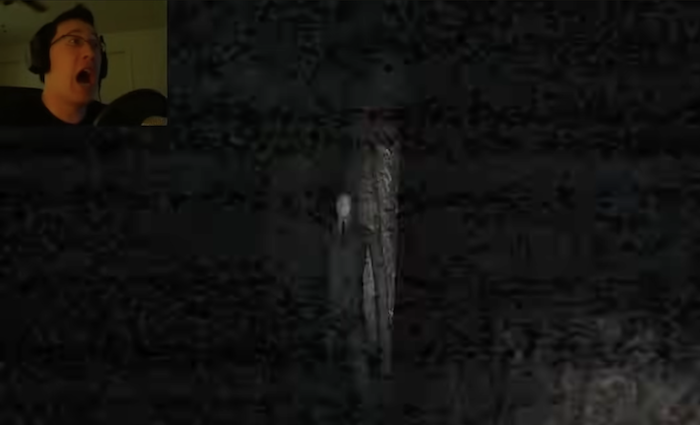


Why is Slender Man scary?
Over the years I have seen many people successfully answer this question. Here are my personal thoughts on the matter.
Mimicry is a common strategy used by predators to approach unsuspecting prey. As soon as you look closely, you will see that this thing is trying to trick you. At the very least, it is trying to observe you without attracting notice. The fact that it doesn't quite succeed may imply additional alienness as it fails to understand you.
Many people have commented on the uncanniness of Slender Man's design, the disorienting combination of familiar and unfamiliar, the not-quite-rightness that hits the human brain in such a specific and compelling way.
Slender Man's human shape implies human intelligence, priming your mind for human interaction, but with no face, there's no way to judge its intentions, a perilous combination that successfully inspires fear. Man is the most dangerous animal, as they say.
On June 10, 2009, shortly after Eric Knudsen posted the first two Slender Man photos, Something Awful user Leyendecker replied: "when i finally saw the guy in the background i lost it this is going to give me nightmares"
Slender Man's Where's Waldo? horror quality was further cemented in Marble Hornets (2009-2014), where the characters discover video evidence that Slender Man was present in various moments of their lives without their knowledge, hiding in the background, even attacking them during events they can't remember.
The hypervigilance inspired by these discoveries drives the characters into stress-induced madness. They barely sleep.
Body horror
Camilla: You, sir, should unmask.
Stranger: I wear no mask.
Camilla: (Terrified, aside to Cassilda) No mask? No mask!
The King in Yellow (1895)
In The Matrix (1999), Thomas Anderson's mouth horrifically seals itself shut during an interrogation by an anonymous group of agents, a scene that seared itself into the minds of viewers for many reasons.
Humans and other animals have specific sets of neurons called "mirror neurons" that fire while we are observing the actions, emotions, and suffering of others, possibly existing so that we can understand others' experiences through internal emulation.
Running on the same track as the Wachowskis, Slender Man's whole face is sealed over in the majority of depictions, with the most human means of communication, sensation, even eating and breathing gone. This extreme deprivation is distressing for the viewer to imagine, especially prompted by Slender Man's otherwise human appearance.
Uncanniness extended into spaces
What is a guy in a business suit doing wandering around in the middle of the woods?
Part of Slender Man's spookiness comes from distinctly mismatching his typical contexts. Many Slender Man stories and artworks place him in forested settings and abandoned locations, places where he seems to have no business being. This is notebly highlighted in one of the character's most famous depictions, Slender: The Eight Pages (2012), which takes place entirely in the middle of the woods at night.
This mismatch between subject and surroundings creates an unease in the witness as their understanding of the world is challenged. The dissonance also helps reinforce the eerie failed humanness of the character.
Ambiguity of experience and loss of control
From the caption of the first Slender Man photo: "we didn't want to go, we didn't want to kill them, but its persistent silence and outstretched arms horrified and comforted us at the same time..."
Many stories about Slender Man capitalize on this ambivalence between desire and terror, a potent and compelling combination in horror fiction. Slender Man with its arms outstretched became a common motif, and many characters found themselves unable to resist the invitation. The embrace, however, is a snare.
We can see that the concept of proxies (if not the name) was established in the very first post. Throughout works about Slender Man, through some inexplicable process, he compels his victims to do his evil bidding. Exposure is also repeatedly shown to induce madness, another state that people fearfully perceive as a loss of control.
The whiteness of the whale
From Moby-Dick (1851), Chapter 42: "Aside from those more obvious considerations touching Moby Dick, which could not but occasionally awaken in any man's soul some alarm, there was another thought, or rather vague, nameless horror concerning him, which at times by its intensity completely overpowered all the rest; and yet so mystical and well nigh ineffable was it, that I almost despair of putting it in a comprehensible form. It was the whiteness of the whale that above all things appalled me."
This one probably isn't that deep. Slender Man's extreme pallor taps into western cultural associations with skeletons, corpses, ghosts, and vampires.
Deeper